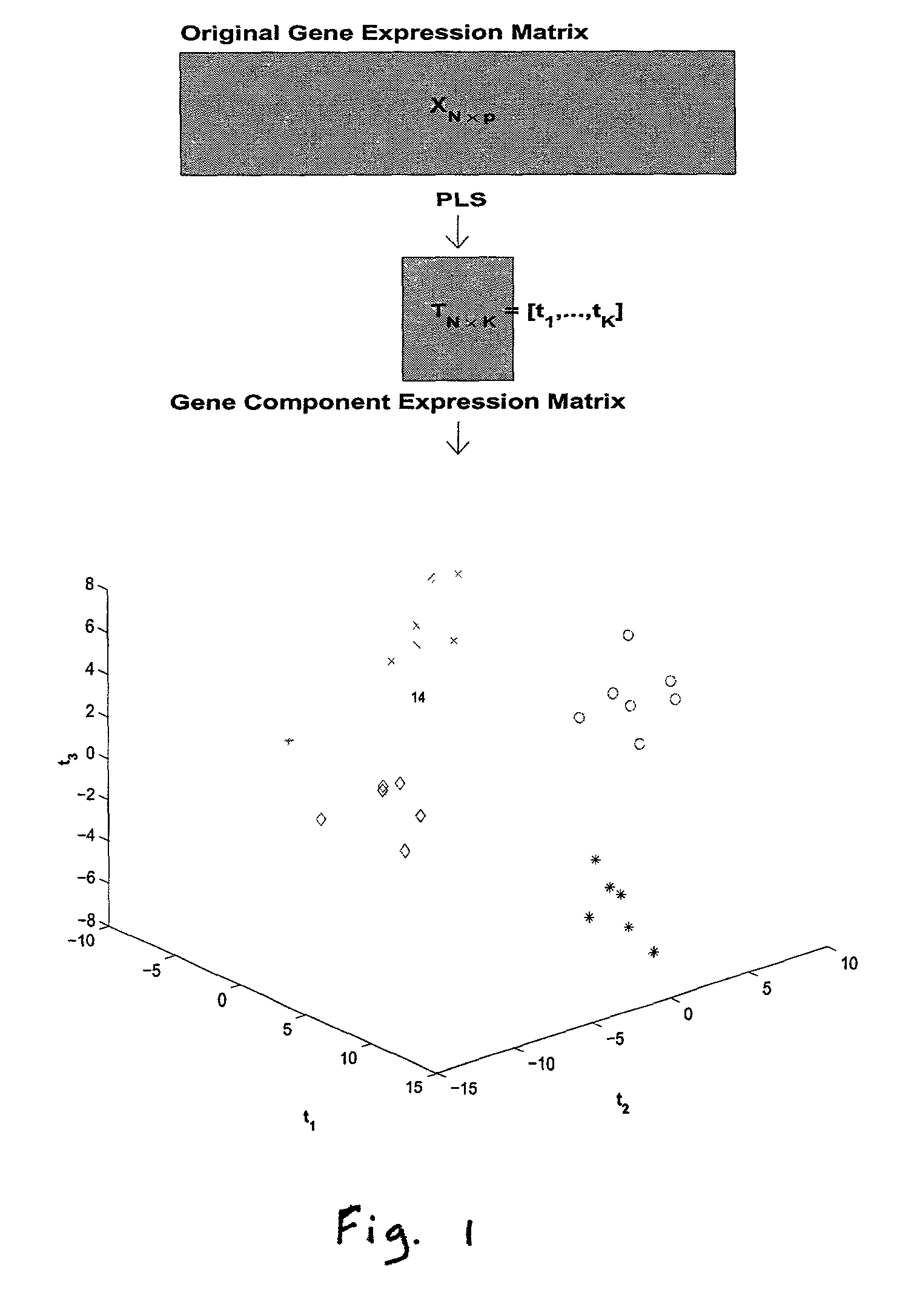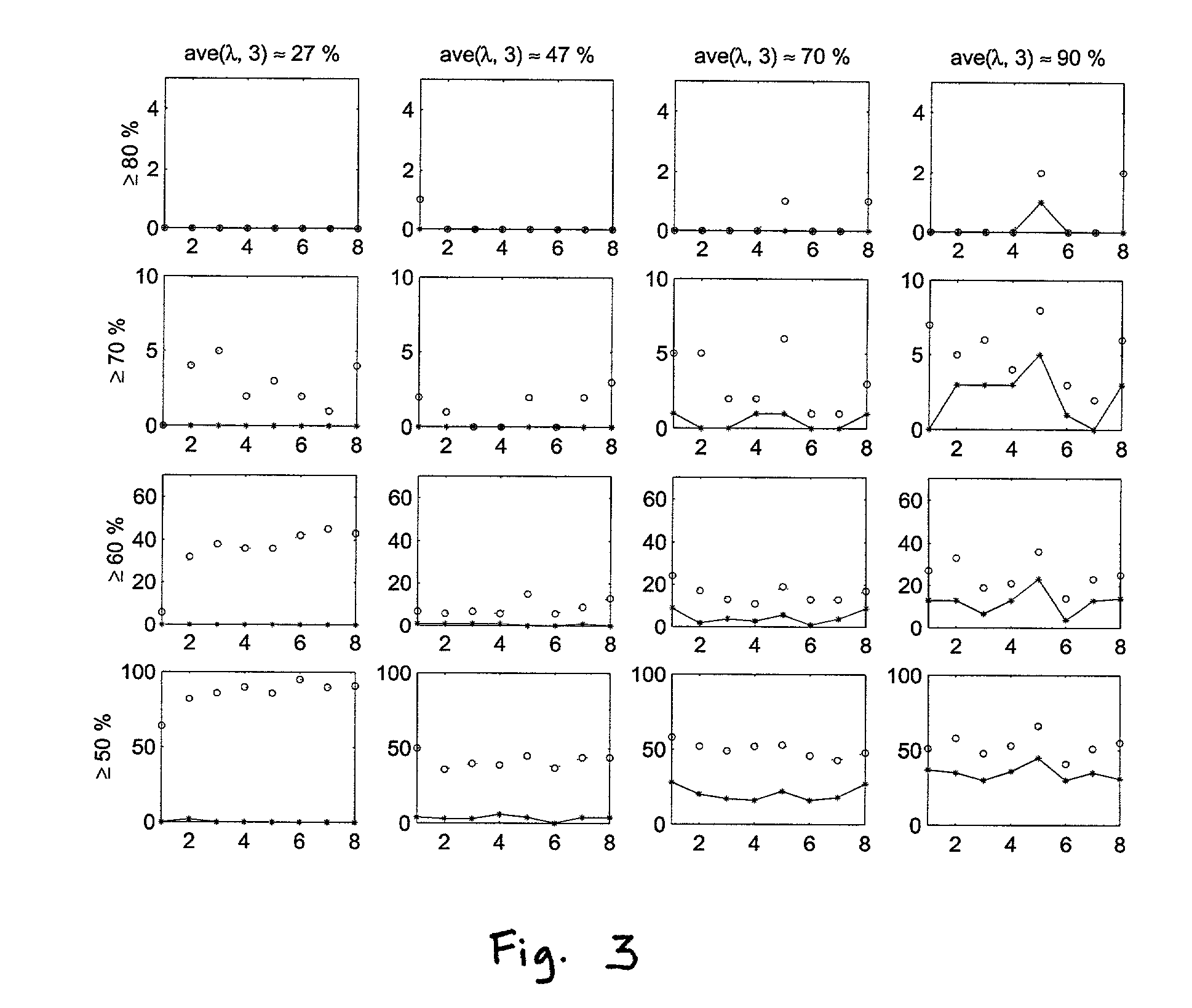Methods for classifying high-dimensional biological data
a biological data and high-dimensional technology, applied in the field of biostatistics, can solve the problems of over-difficulty in determining which genes, methods requiring n>p to be of no direct use, etc., and achieve the effect of assessing confiden
- Summary
- Abstract
- Description
- Claims
- Application Information
AI Technical Summary
Benefits of technology
Problems solved by technology
Method used
Image
Examples
example 1
3.1.1. EXAMPLE 1
Ovarian Data
[0075]The microarray experiments consist of hybridizations of normal and ovarian tissues on arrays with probes for 97,802 cDNA clones. The ovarian data set considered here consists of 16 normal tissue samples and 14 ovarian tumor tissue samples. The normal tissue samples consist of a spectrum of normal tissues: 2 cyst, 4 peripheral blood lymphocytes, 9 ovary and 1 liver normal tissue. All normal and tumor samples are distinct, coming from different tissues (patients). We log transformed all the gene expression values due to the highly skewed data, typical of gene expression data. The expression of all genes also were standardized to have mean zero and standard deviation of one across samples.
[0076]We considered p*=50,100, 500, 1000, 1500 genes selected as described in the Methods section. Since there are few samples, we made leave-out-one CV prediction. Classification of the 30 tissue samples based on K=3 gene components constructed from p* genes using PL...
example 2
3.1.2. EXAMPLE 2
Leukemia Data
[0079]The data set used here is the acute leukemia data set published by Golub et al. (1999). The original training data set consisted of 38 bone marrow samples with 27 acute lymphoblastic leukemia (ALL) and 11 acute myeloid leukemia (AML) (from adult patients). The independent (test) data set consisted of 24 bone marrow samples as well as 10 peripheral blood specimens from adults and children (20 ALL and 14 AML). Four AML samples from the independent data set were from adult patients. The gene expression intensities were obtained from Affymetrix high-density oligonucleotide microarrays containing probes for 6,817 genes. We log transformed the gene expressions to have a mean of zero and standard deviation of one across samples. No further data preprocessing was applied.
[0080]We first applied the methods of the invention to the original data structure of 38 training samples and 34 test samples for p*=50, 100, 500, 1000, and 1500 genes selected as describe...
example 3
3.1.3. EXAMPLE 3
Lymphoma Data
[0087]The lymphoma data set was published by Alizadeh et al. (2000) and consists of gene expressions from cDNA experiments involving three prevalent adult lymphoid malignancies: diffuse large B-cell lymphoma (“DLBCL”), B-cell chronic lymphocytic leukemia (“BCLL”) and follicular lymphoma (“FL”). Each cDNA target was prepared from an experimental mRNA sample and was labeled with Cy5 (red fluorescent dye). A reference cDNA sample was prepared from a combination of nine different lymphoma cell lines and was labeled with Cy3 (green fluorescent dye). Each Cy5 labeled target was combined with the Cy3 labeled reference target and hybridized onto the microarray. Separate measurements were taken from the red and green channels. We analyzed the standardized log relative intensity ratios, namely the log(Cy5 / Cy3) values. To test the binary classification procedures of the present invention, we analyzed a subset of the data consisting of 45 DLBCL and 29 BCLL samples w...
PUM
 Login to View More
Login to View More Abstract
Description
Claims
Application Information
 Login to View More
Login to View More - R&D
- Intellectual Property
- Life Sciences
- Materials
- Tech Scout
- Unparalleled Data Quality
- Higher Quality Content
- 60% Fewer Hallucinations
Browse by: Latest US Patents, China's latest patents, Technical Efficacy Thesaurus, Application Domain, Technology Topic, Popular Technical Reports.
© 2025 PatSnap. All rights reserved.Legal|Privacy policy|Modern Slavery Act Transparency Statement|Sitemap|About US| Contact US: help@patsnap.com



